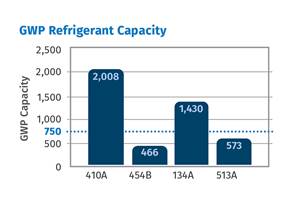Air-Ring Upgrades Get Film Processor Quickly Up to Spec
PolyExpert’s trials lead to installation of three new air rings and one digital IBC control to speed changeovers and reduce scrap.
For blown-film processors serving high-end film markets, quality and the agility to shift quickly from one product to another generally trump line speed. While suppliers of blown-film extrusion equipment are developing complete engineered systems to provide just such performance, in some cases a far less costly investment in a new component or two can generate comparable results.
That’s been the experience of ., Laval, Quebec, which bills itself as Canada’s largest non-integrated polyethylene film processor (meaning it doesn’t compete with its customers). The firm was founded in 1979 by Gilles and Ghislaine Plante and to this day remains a family-owned and operated ┤¾¤¾┤½├¢. Its 75,000 ft² plant employs 120 people; 15 film lines run around the clock. Capacity is split between single- and three-layer structures and includes two high-stalk lines for HMW-HDPE.
PolyExpert initially focused on producing converter film, recalls David Douse, general manager. Over the years, however, it has diversified and now produces films in gauges from 0.4 to 6 mil for a wide range of applications, among them lamination sealant films; agricultural mulch films; bags for bread, diapers, ice, and courier applications; as well as rollstock for vertical and horizontal form-fill-seal, frozen food, and bottle sleeves. Layflat widths range from 18 to 90 in.
When equipment enhancements are needed, PolyExpert will either buy a complete new system or look to upgrade an existing line with critical new-generation components. Last year, it evaluated various ways to improve film quality on three of its older lines. “Our goal is to produce the highest-quality film from all of our lines,” notes Douglas Lord, v.p. of operations. “On three of our lines that are about 10-years old, we evaluated new air-ring technology,” Lord recalls. “The air rings on these particular lines—7, 12, and 14 in.—were standard designs, and we wanted to upgrade to a system that offered automatic gauge control.” PolyExpert brought in several air rings as part of an evaluation process, and at the end settled on three new dual-lip External Gauge Control (EGC) units supplied by ., Stoughton, Mass.
The EGC air ring is equipped with horizontally sliding teeth that adjust the air flow through the radially located vanes in the air ring’s plenum, causing preferential cooling on the outside of the bubble. A circuit board inside the air ring converts the mapped thickness profile into instructions for the scanning actuator, which slides a multitude of fingers (120 to 252, depending on air-ring size) in or out as needed, to open or close the airflow channels. Film thickness variation is corrected by the automatic adjustment of the airflow through the air ring’s vanes.
“The really important issue for us was to select an air ring that allowed us to hit our target gauge quickly,” states Lord. “With all the air rings we looked at, the throughput rates we were getting were about the same. But the factor that swayed us toward the EGC was the adjustment speed. We make a lot of different products on the same line, so what’s important to us is to reduce setup times and really tighten the time it takes to produce commercial-quality film, which reduces scrap rates.” Compared with its previous air rings, the Addex EGC provided a 50% improvement in thickness control for all products on all three lines, Lord states.
One of the three EGC-equipped lines is also furnished with Addex’s Digital Internal Bubble Cooling (DIBC) system, which is said to deliver the fastest reaction time in the industry to ensure precise bubble control, helping processors to speed product changeovers and significantly reduce scrap. The five-sensor system features a high-speed, servo-controlled air-regulation valve that performs split-second corrections in bubble size (up to 20 adjustments per second). Users reportedly have switched from a 40-in. layflat to a 60-in. layflat in seconds instead of the minutes it took with the previous system.
All told, PolyExpert invested about $150,000 per line on the upgraded components, significantly less than it would have cost to buy just one complete new line. Lord says the company expects to buy one or two more EGC systems this year.
Related Content
Temperature Control: What You Need to Know to Comply With New Cooling-Fluid Regs
Beginning the first of this year, 12 states are following EPA bans on potentially damaging cooling fluids. Chiller suppliers have adjusted equipment designs to accommodate the new regulations. Here’s what all this means to processors.
Read MoreConair Names New Head of Customer Care
Jared Helfrich to direct the efforts of the machine builder’s growing customer care group, combining its existing parts and service and repair organization with a new range of fast-growing customer services.
Read MorePiovanGroup Rebrands, with Mostly Minor Name Changes
For the most part, subsidiary company names will remain, with slight modifications meant to enhance the Group’s identity.
Read MoreACS Group Adds Regional Sales Manager
Richard Gutierrez named Southwest regional sales manager.
Read MoreRead Next
People 4.0 – How to Get Buy-In from Your Staff for Industry 4.0 Systems
Implementing a production monitoring system as the foundation of a ‘smart factory’ is about integrating people with new technology as much as it is about integrating machines and computers. Here are tips from a company that has gone through the process.
Read MoreLead the Conversation, Change the Conversation
Coverage of single-use plastics can be both misleading and demoralizing. Here are 10 tips for changing the perception of the plastics industry at your company and in your community.
Read More












